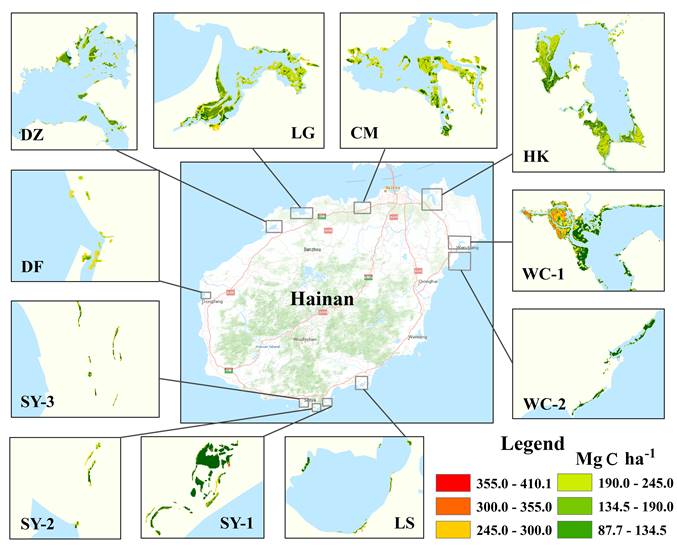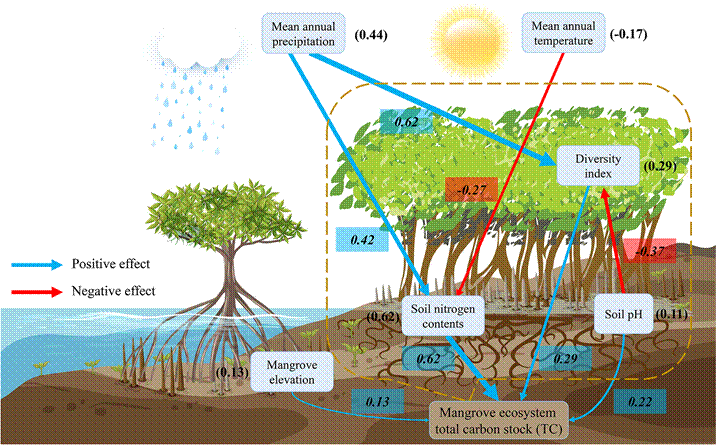As important coastal "blue carbon" ecosystems, mangrove forests have a powerful carbon sink function and play an important role in mitigating atmospheric carbon dioxide concentration and slowing down global climate change. Globally, mangrove forests are mainly distributed along the coastal zones of tropical and subtropical areas, characterized by fragmented habitats, uneven distribution, and high spatial heterogeneity.
Traditional methods of carbon stock investigation with high cost and low efficiency restrict the long-term and large-scale estimation and monitoring of mangrove carbon stock distribution. It is therefore imperative to establish a timely and accurate method to estimate mangrove carbon stocks in a large area. In this regard, the Research Group took Hainan Island, a representative distribution area of mangrove forests in China, as a case study site (Fig. 1), and improved the estimation method of ecosystem carbon stocks by combining field surveys and remote sensing technology,

Fig. 1 Distribution of mangrove ecosystem carbon stocks of Hainan Island.
Based on the research results published by Lin Guanghui's Research Group in Carbon Balance and Management in 2021, this study further explored and applied the relationship between the above- and below-ground mangrove carbon stocks. Based on the field sample survey and Sentinel-2 high-precision remote sensing images, the estimation method of total mangrove carbon stocks (including above-ground and below-ground carbon stocks) was developed, and the existing blue carbon stocks of mangrove forests on Hainan Island were quantitatively estimated, which verified the feasibility of this method in analyzing the pattern on a regional scale. It was found that the blue carbon stocks of mangrove forests on Hainan Island were about 703,000 tons of carbon, of which the below-ground carbon stocks accounted for about 75% of the total carbon. Among all prefecture-level cities, mangrove forests in Haikou City (where Dongzhai Port National Mangrove Nature Reserve is located) and Wenchang City (where Qinglan Port Provincial Mangrove Nature Reserve is located) not only had the highest blue carbon density (Figure 1), but also accounted for the highest proportion of the total blue carbon on the whole island (43.3% and 24.3% respectively). The Research Group studied the driving effects of different biological (vegetation community diversity, etc.) and abiotic factors (soil physical and chemical characteristics, climate factors, etc.) on carbon stock distribution of mangrove forests (Fig. 2), and discussed the improvement potential of mangrove blue carbon estimation application in larger scale space in the future.

Fig. 2 Schematic diagram of structural equation model (SEM) analysis results of total carbon (TC) stocks in mangrove forest ecosystem
Based on high-precision satellite remote sensing images, the new method of mangrove blue carbon storage developed by the research group can provide a reference for quantifying, monitoring and measuring blue carbon potential of mangrove forests on a regional or global scale, and can also better guide mangrove restoration and rehabilitation projects aimed at improving blue carbon sinks, serving local, national and global mangrove wetland preservation and restoration.
Recently, the research results have been published online in a paper titled “Spatial patterns and driving factors of mangrove carbon stocks on Hainan Island, China” in Global Ecology and Biogeography. Meng Yuchen, a 2017 doctoral student, and Gou Ruikun, a 2019 doctoral student in the Department of Earth Science System (DESS), Tsinghua University, are the co-first authors of the paper; Prof. Lin Guanghui of the DESS, Tsinghua is the corresponding author. Prof. David Moreno-Mateos and Prof. Charles C. Davis of Harvard University, A/Prof. Zhu Xiaoshan of Shenzhen International Graduate School of Tsinghua University, Assistant Prof. Zhang Hongsheng of Hong Kong University, Dr. Bai Jiankun, Dr. Wan Roman and doctoral student Song Shanshan who participated in the research are the co-authors of the paper. This research was supported by the National Key R&D Program of China, National Natural Science Foundation of China and Key Projects Stability Support of Universities in Shenzhen.
Paper link:
Meng, Y., Gou, R., Bai, J., Moreno-Mateos, D., Davis, C. C., Wan, L., Song, S., Zhang, H., Zhu, X., & Lin, G. (2022). Spatial patterns and driving factors of mangrove carbon stocks on Hainan Island, China. Global Ecology and Biogeography, 00, 1–15.
https://doi.org/10.1111/geb.13549
Related research papers of the Research Group:
Meng Y.C., Bai J.K., Gou R.K., Cui X.W., Feng J.X., Dai Z., Diao X.P, Zhu X.S., Lin G.H. 2021. Relationships between above- and below‑ground mangrove carbon stocks facilitate better estimation of total mangrove blue carbon. Carbon Balance and Management 16:8, 10.1186/s13021-021-00172-9
Bai J., Meng Y., Gou R. Lyu J.C., Dai Z., Diao X.P., Zhang H.S., Lu Y.Q., Zhu X.S., Lin G.H. 2021. Mangrove diversity enhances plant biomass production and carbon storage on Hainan Island, China. Functional Ecology 35:774-786. DOI: 10.1111/1365-2435.13753.
Hu T., Zhang Y.Y., Su Y., Zheng Y., Lin G.H., Guo Q.H. 2020. Mapping the global mangrove forest aboveground biomass using multisource remote sensing data. Remote Sensing 12, 1690. 10.3390/rs12101690.
Contributed by Meng Yuchen, Gou Ruikun and Lin Guanghui
Edited by Wang Jiayin
Reviewed by Zhang Qiang